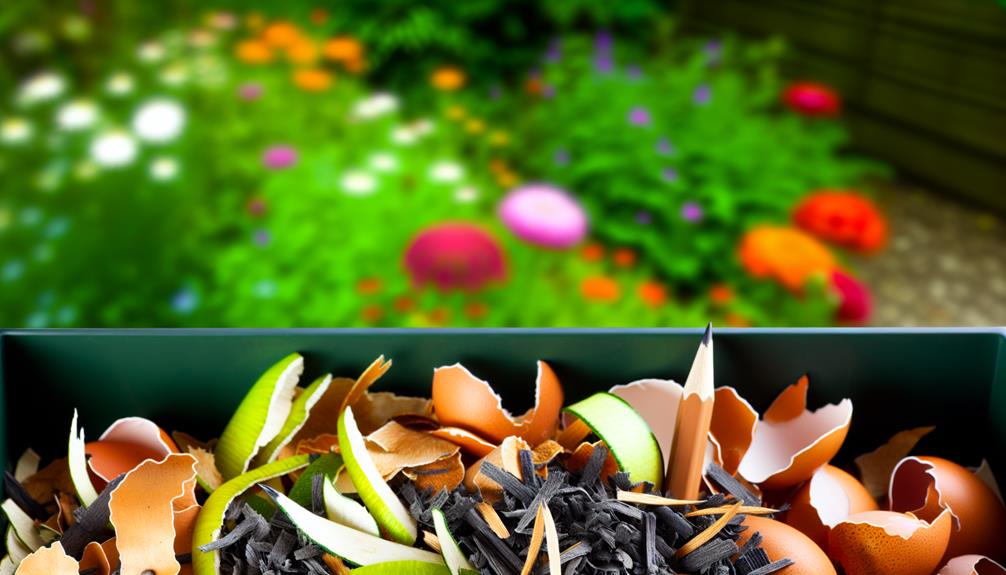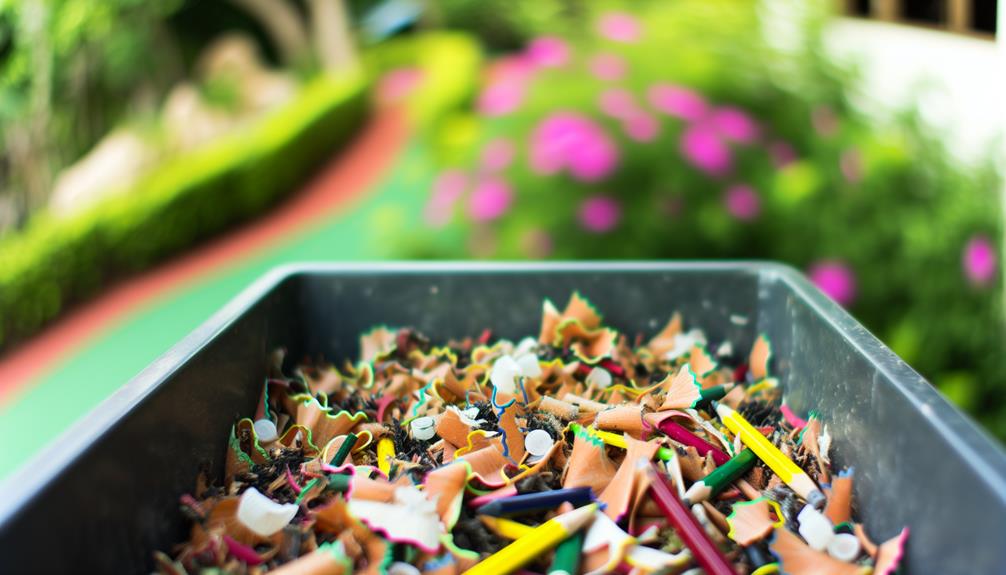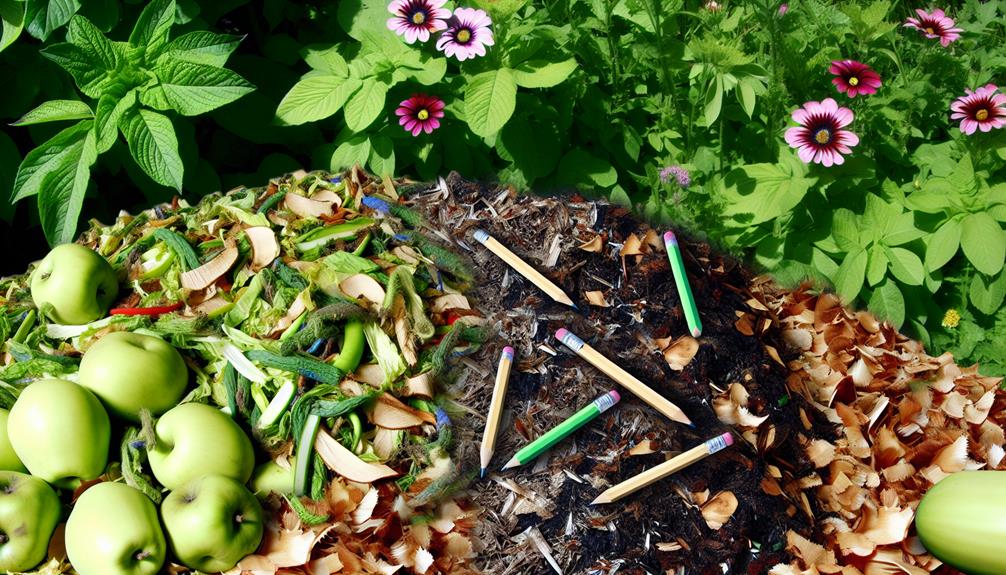

Yes, you can compost pencil shavings. However, make sure they’re free from synthetic materials and chemicals. The natural wood and graphite in shavings break down efficiently, enriching your compost and improving soil structure. To compost effectively, layer pencil shavings with other compostable items, ensuring good aeration and moisture balance.
Regularly turn the pile and maintain a moisture level similar to a wrung-out sponge. Avoid shavings from pencils with dyes or synthetic substances as they may harm the compost quality. If you manage your compost correctly, you’ll get a nutrient-rich addition to your garden. Mastering these tips can enhance your composting efforts.
Pencil shavings are the small, curly remnants left behind after sharpening your pencil. They often accumulate in classrooms, offices, and homes, but understanding what they’re and how they’re made can give you a sense of connection to their potential uses.
Pencil materials vary, with most traditional pencils being made of wood and graphite. Some modern pencils also incorporate synthetic materials. These different materials influence the types of shavings you get—wooden shavings are typically longer and curlier, while synthetic ones can be shorter and more brittle.
When you sharpen your pencil, you’re creating two primary types of shavings: those from the outer casing and those from the inner core. The outer casing, usually wood, provides the bulk of the shavings, while the inner core, made of graphite or a similar substance, contributes a finer, dust-like residue. Recognizing these distinctions helps you better manage and utilize your pencil shavings.
Instead of letting them go to waste, you can turn pencil shavings into a valuable resource by composting them. Not only does this practice promote waste reduction, but it also contributes to soil enrichment. By adding pencil shavings to your compost pile, you’re making a positive impact on both your garden and the environment.
Here are four benefits of composting pencil shavings:
Also Read: Can You Compost Yogurt?
While composting pencil shavings offers numerous benefits, you should also consider a few potential drawbacks. One significant concern is chemical contamination. Many pencils contain dyes and synthetic materials that could introduce harmful chemicals into your compost. These substances mightn’t break down fully and could impact the quality of your compost, potentially harming your plants.

Another issue is the environmental impact. Some pencils are made from wood treated with chemicals to enhance durability and resistance to pests. These treatments can leach into your compost, posing a risk to the beneficial microorganisms essential for composting. Additionally, if your pencils have rubber or plastic components, these won’t decompose, further complicating the composting process.
Moreover, the volume of pencil shavings you produce might be minimal, making it less effective to compost them separately. Instead, you could combine them with other compostable materials, but this requires careful management to avoid imbalances.
Lastly, don’t overlook the possibility of contaminating your compost with non-biodegradable materials accidentally. It’s important to be vigilant about what goes into your compost pile to maintain its integrity and effectiveness. Consider these factors carefully to make informed decisions about composting pencil shavings.
Also Read: Can You Compost Cactus?
To effectively compost pencil shavings, start by confirming they’re free from non-biodegradable materials like plastic or rubber. Once you’ve sorted the shavings, you can add them to your compost bins as a valuable carbon source.
Here’s a simple guide to follow:
Also Read: Can You Compost Butter?
Now that you know how to compost pencil shavings, let’s explore some tips to enhance your overall composting process. Proper aeration and moisture balance are essential for effective composting. Guarantee your compost pile gets enough oxygen by turning it regularly. This prevents it from becoming anaerobic and producing unpleasant odors. Aim to turn your pile once a week.

Maintaining the right moisture balance is equally vital. Your compost should be as damp as a wrung-out sponge. If it’s too dry, add water; if too wet, add dry materials like shredded newspaper or dried leaves.
Adding a variety of green (nitrogen-rich) and brown (carbon-rich) materials will help create a balanced compost.
Here’s a quick reference table to guide you:
| Green Materials | Brown Materials | Tips for Balance |
|---|---|---|
| Vegetable scraps | Dried leaves | Maintain a 2:1 ratio |
| Grass clippings | Shredded newspaper | Turn weekly for aeration |
| Coffee grounds | Pencil shavings | Monitor moisture levels |
You might wonder if all pencil shavings are compostable. Most wood types and graphite content are safe for composting, but avoid shavings from colored or treated pencils. Your compost pile will thrive with the right materials.
You’re concerned about pests in your compost bin? Don’t worry! For pest prevention, make sure you mix pencil shavings evenly with other materials. Compost layering will help keep your compost healthy and pest-free, creating a welcoming community for all gardeners.
You can compost colored pencil shavings, but make sure they have non-toxic dyes. Avoid shavings with chemical residues to keep your compost healthy. By doing this, you contribute to a safe, eco-friendly community.
You’re probably wondering about the decomposition rate of pencil shavings. As organic matter, they usually take around 6 months to a year to decompose, depending on conditions like moisture and temperature. We’re all in this together!
You’re concerned about health risks like toxic substances and lead exposure when composting pencil shavings. Typically, modern pencils don’t contain harmful materials. However, always verify the pencil type to guarantee your compost is safe and healthy.
Composting pencil shavings is a simple way to reduce waste and enrich your compost. Verify that the shavings are from natural, untreated wood and avoid those mixed with plastic or synthetic materials.
Add shavings in moderation to balance your compost’s carbon-nitrogen ratio. Regularly turn your compost to promote decomposition.
By following these steps, you’ll effectively compost pencil shavings and contribute to a more sustainable environment.
